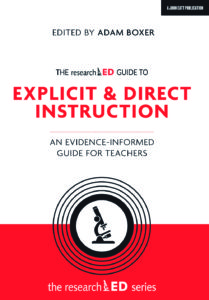When teachers hear that “research shows we should do X,” we have at least two broad questions:
questions:
First Question: what’s the research?
Second Question: what EXACTLY does X look like in the classroom?
People who have the expertise to answer the first question (researchers) might not have the K-12 classroom experience to answer the second question.
And, of course, people who can make it work in the classroom (teachers) might not know or understand the research.
Wouldn’t it be great if we could find one book that answers both sets of questions?
In fact, it would be especially great if that book focused on a controversial topic. In that case, we could see a complete argument – both the why and the how – before we make a judgment about the controversy.
Does that sound tempting? I have good news…
Embracing Controversy
A feisty battle has raged in edu-circles for many years now: “direct instruction” vs. “constructivist pedagogy.” *
In one corner, “constructivists” argue that problems or projects or independent inquiries help students discover and build enduring understanding. And, such exploration fosters authentic motivation as well.
In the other corner, “direct instruction” advocates argue that working memory limitations sharply constrain students’ cognitive workspace. For that reason, teachers must explicitly shape learning experiences with small steps and carefully-designed practice.
Both approaches can be – and frequently are – parodied, misunderstood, and badly practiced. So, a book explaining the WHY (research) and the HOW (classroom practice) would be greatly helpful.
Sage on the Page
Adam Boxer teaches chemistry at a school in London, and has been blogging about his work for some time now. (If you follow our twitter account, @LearningandtheB, you’ve seen links to his work before.)
In his book Explicit & Direct Instruction: An Evidence-Informed Guide for Teachers, Boxer gathers eleven essays that explain the research background and then then get SUPER specific with classroom suggestions.
In the first chapter, Kris Boulton tells the history of “Project Follow Through,” a multi-decade program to discover the best way of teaching children.
Researchers tracked more than 200,000 children in 13 different programs over several years, and compared their learning across three dimensions: basic skills, cognitive skills, and affective skills.
Which approach proved most effective?
Direct Instruction, created by Siegfried Engelmann.** It was, in fact, the only program of the 13 that benefitted students in all three dimensions.
When advocates of Direct Instruction (and direct instruction) insist that research shows its effectiveness, they reasonably enough point to Project Follow Through. (Can others critique this study? Of course…)
Both Boulton and Greg Ashman (in the second chapter) then emphasize the alignment of direct instruction with psychology models: cognitive load theory, schema theory, and so forth.
In brief: we’ve got LOTS of research explaining why direct instruction should work, and showing that it does work.
Let’s Get Practical
After Boulton and Ashman explain the why, the next several chapters deliver on the classroom how.
For me, the book’s great success lies in the number, variety, and specificity of these chapters.
What does direct instruction look like for teaching math?
How about science?
How about writing?
What’s the best number of examples to use?
And so forth.
I especially enjoyed Sarah Cullen’s chapter on fading. Cullen begins with an important question/critique:
How, then, can a teaching method that so depends on instruction – on teachers leading learning and controlling the content to which pupils are exposed – foster autonomy?
Her answer focuses on having scaffolds and removing scaffolds – aka, “fading.”
In particular, Cullen wisely conceptualizes fading over many different time spans: fading across grades (which requires planning across years), fading within a term’s curriculum (requiring planning across months), and fading within a lesson (requiring skill, insight, and practice).
Like the book’s other chapters, Cullen’s offers many specific examples for each of her categories. In other words, she ground theoretical understanding with highly specific classroom realities.
In Brief
If you already think direct instruction sounds right, you’ll be glad to have a how-to guide.
If you think it sounds suspect (or even oppressive), you’ll be glad to read a straightforward explanation of the research behind the approach. (You might not be persuaded, but you’ll understand both sides of the argument more clearly.)
And, if you want realistic classroom examples explained with loving detail, this book will launch 2022 just right.
* I’ve put those labels in quotation marks because both are familiar, but neither one really works.
** Direct Instruction (with capital letters) is the name of Engelmann’s specific program. On the other hand, direct instruction (without capital letters) is a broader approach to thinking about teaching and learning.



